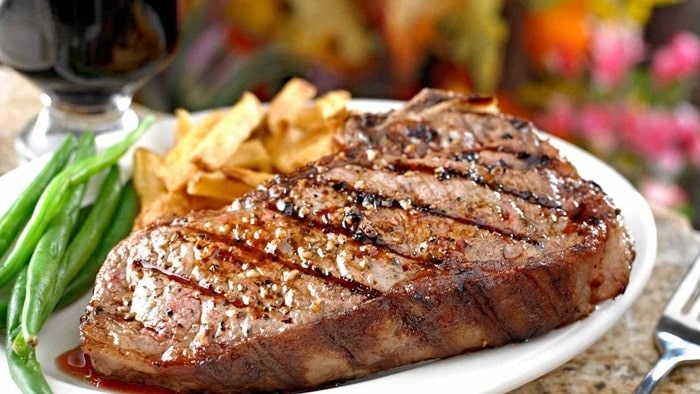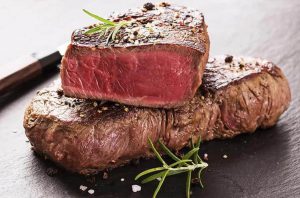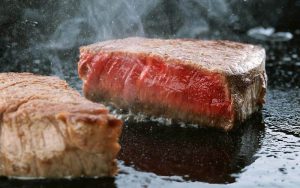In the landscape of American cuisine, there’s one undisputed culinary hero: the steak. Symbolic of both rustic tradition and the luxuries of contemporary dining, it embodies a culture that champions bold flavors and generously portioned meals.
From smoky backyard barbeques to the gleaming elegance of fine dining establishments, steak cuts across class and occasion, claiming its place as America’s favorite indulgence.
Defining regions and inspiring chefs, each cut unfurls a flavor profile as diverse as the nation itself.
The buttery tenderness of filet mignon whispers tales of high-end glamour, while juicy slices of sirloin echo through family kitchens where hearty food reigns supreme.
With magic in its marbling and versatility in its veins, steak is woven into the very fabric of national festivities and simple pleasures alike.
Across the United States of America, steak is not just a meal; it’s a culinary canvas that reflects the diverse tastes and traditions of its states.
Each region has cultivated its own steak preference, often shaped by local history, agriculture, and cultural influences.
Here’s an exploration of how steak preferences can vary from one state to another:
- Popular Cuts Of Meats By States
- Additional Beef Cuts In The United States
1. Texas (Georgia – Massachusetts, New Hampshire)
In the Lone Star State, beef is king, and steaks are no exception. Texans favor thick cuts like ribeyes or T-bones that handle well against the intense heat of a barbecue pit.
Seasoning tends to be simple yet robust—salt and pepper with maybe a touch of cayenne for kick—prioritizing the natural flavor of their high-quality beef.
2. Ribeye Steak
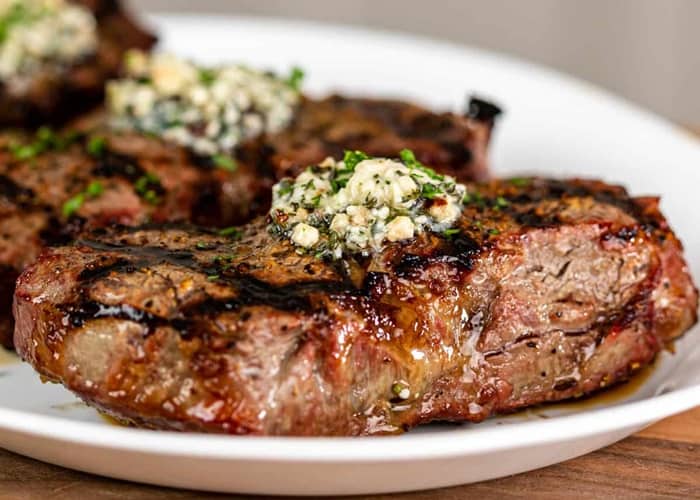
Expertly carved from the cow’s prime rib section—specifically between ribs six through twelve—the cut boasts a generous amount of marble fat.
This isn’t just any fat; it’s key to why connoisseurs celebrate ribeyes above all else. As this marbled glory melts away during cooking, it infiltrates the steak with unmatched succulence and taste that will have your taste buds singing praises.
The flavorful journey doesn’t end there. Whether presented as an impressive bone-in tomahawk or a classic boneless option, dry-aged ribeyes transmit tenderness and nuanced flavors developed through patient aging in precise conditions usually found at upscale steakhouses.
Savoring a ribeye—juicy on your plate after sizzling on a hot skillet or pulled off the grill with its edges crisped to perfection—is not merely enjoying a meal; it’s indulging in a divine gustatory experience that transcends mere sustenance.
2. Kansas
Home to some of America’s most historic cattle towns, Kansas prefers steaks cut from grain-fed cows giving them a rich marbling.
The classic Kansas City strip steak—a boneless top loin with an ideal balance of tenderness and flavor—pays homage to this tradition.
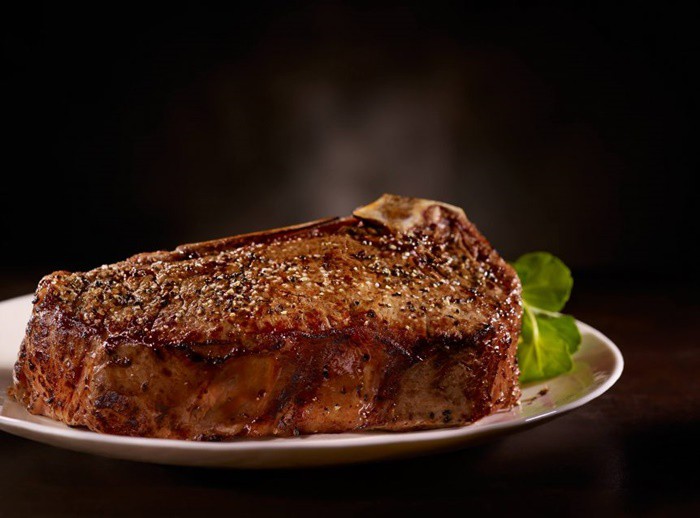
Ever heard of the Kansas City Strip Steak? If not, you’re in for a treat. This cut is all about indulgence with its melt-in-your-mouth tenderness and rich marbling that promises a burst of flavor in every bite.
What makes it extra special is that bone-chilling with your steak – it’s like an amplifier for taste!
Now, let’s talk about what sets this bad boy apart from its cousin, the New York Strip.
Besides the fact that you’re getting some bone action with the Kansas City version (which we’ve established means more yumminess), they can also be a smidge thicker and come boasting different levels of fat and marbling patterns.
These distinctions might sound small, but trust me – they take your eating experience to whole new levels of deliciousness.
Pricing? Oh, yeah! The Kansas City Strip Steak offers awesome value at around $12-$14 per pound. Whether you’re scouring online shops or hitting up local butchers known for their carnivorous delights, snagging one won’t break the bank.
Let’s delve into a fun little history lesson: cast your mind back to 1827 when the Delmonico brothers coined ‘Kansas City Strip Steak’. Fast forward to today and this steak has captured hearts across dinner tables everywhere as an affordable luxury—people just can’t get enough of its beefy charm compared to pricier options like New York Steak.
The roots of our star steak stretch deep into America’s heartland – think Midwest cattle ranchers living out their pastoral dreams under wide open skies.
It’s named after none other than Kansas City itself; once upon a time (we’re talking late 1800s to early 1900s here), it was THE spot where cowboys drove their herds before these beauties made their way onto plates far and wide.
So when you munch down on a Kansas City Strip Steak, remember it’s more than just meat – it’s culinary heritage nestled right next to those crispy fries on your plate!
For surefire satisfaction, aim for that high-grade stuff that boasts undeniable tenderness teamed up with luscious stripes of fat – because each piece should be nothing short of fantastic!
3. Chicago
This city’s love affair with beef gave rise to the famous “Chicago-style” steak preparation: seared on the outside for crispness then slow-roasted for interior tenderness, often served with seasoning heavy on garlic and onion.
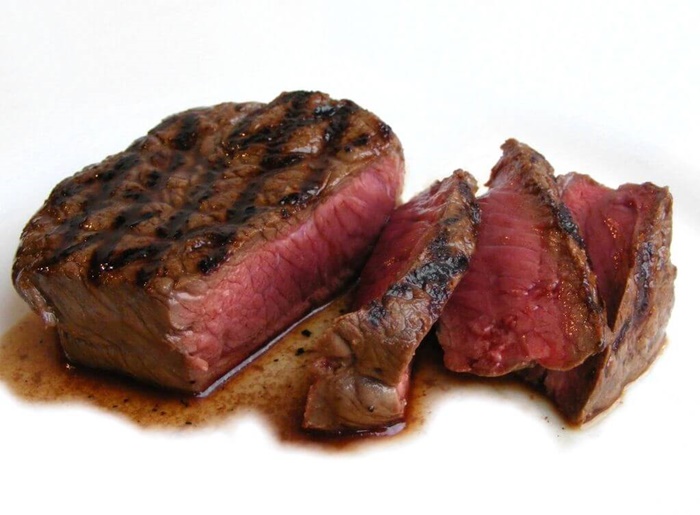
It’s time to let those BBQs sizzle because we’re about to rock your world with a Chicago Style Steak recipe that’s going to be your new favorite thing.
Grab these ingredients:
- An unapologetic amount of butter (you’ll thank us later)
- A splash or two of canola oil
- Kosher salt sprinklings for good measure
- Cracked black pepper like it’s going out of style
- Steaks that are no less than 2″ thick – go big or go home!
Here’s what you need to do:
- Wake up your BBQ by blasting it on high heat. Plop a cast iron skillet onto those grates, shut the lid, and let it do its thing for about fifteen minutes. Meanwhile, give your oven some love by heating it to a roaring 500°F.
- Treat those steaks with all the love they deserve: shower them in salt and pepper before giving them an oil massage with that canola goodness.
- Get up close and personal with butter – toss a nice pad into the pan until it melts into liquid gold; embrace the smoke (that’s why we’re cooking al fresco!)
- Carefully lay your steak into its bubbly bath then introduce even more glorious butter friends to join the party.
- Give ’em a flip! Shower Side B in more heavenly butter; just remember – keep that skillet singing with moisture!
- Once flippin’ fantastic, bring those beauties off the heat so they can chill out on a cooling rack; think Zen garden vibes for steak.
- Right before showtime (a.k.a dinner), throw all of these rested steaks onto something cookie sheet-esque back in their hot box haven for approximately ninety dynamite seconds.
Prepare yourself: you’re about to sit down for one epic meal worthy of fireworks- Cheers & happy sizzling!
4-Nebraska
In corn country, where cattle are often finished on rich corn diets before slaughter, Nebraskans hold prime rib in high esteem—a cut known for its succulency due to exceptional marbling—and it’s commonly enjoyed generously seasoned and slow-roasted.
Rosemary and Garlic-Encrusted Smoked Prime Rib that will have your guests singing your praises.
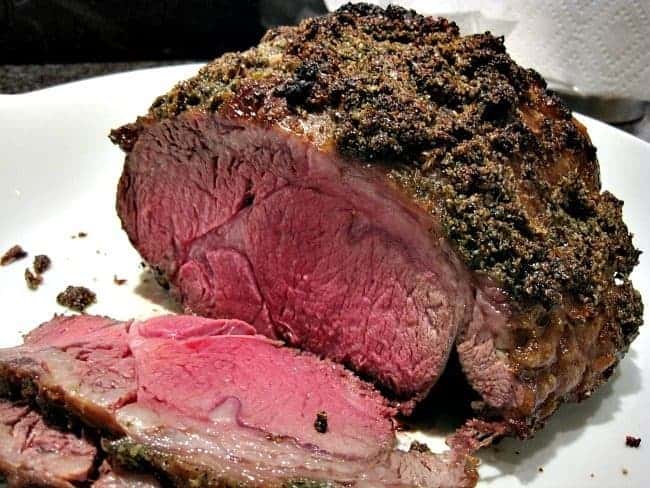
Step 1: Getting Started with Butter Love
First things first – let’s grab that slab of prime rib and give it a loving massage with butter. That’s right, slather all that rich unsalted goodness over the roast without an ounce of guilt. This is the secret handshake into Flavor Town!
Step 2: Amp Up the Aromatics
Next on deck are our fragrant co-stars – minced garlic, thyme, onion powder (because why not!), kosher salt (chef’s kiss!), and a good ol’ crackling of peppercorns. Shower these liberally onto the roast like confetti at a parade.
Now comes the spotlight ingredient – rosemary, fresh as a dewy morning. Press those aromatic sprigs into the meat and tie them down with butcher’s twine.
Give it some chill time uncovered for 2-4 hours because this beauty needs its beauty to sleep at room temperature before taking center stage.
Step 3: Searing Glory
Crank up that grill to a sizzling 450F. Rest your buttered-up prime rib fat cap skyward in its roasting throne fit with a rack beneath.
The searing countdown varies – think “mise en place” rhythm; 30 minutes for those hosting humble gatherings (3-rib) or step it up notch by notch until you reach grand feast territory (45 minutes for 7 ribs).
Now hit pause – allow your masterpiece-in-the-making to rest off-grill for another half-hour at room temperature. Trust me; patience is not just a virtue here – it’s essential!
Step 4: The Low and Slow Waltz
With our meat cozily rested, let’s take it low-temp now – back onto our grill set at an easy-going 225F groove.
Baste away any time she starts looking thirsty while keeping one eye glued to your trusty thermometer until you close in on perfection by about 10-12F shy of target temps.
Then when medium-rare whispers sweetly between 115-120°F or medium beckons warmly with signals around 125-130°F; deliver her from heat!
Tenting time under shiny foil follows—think spa wrap sesh—for another cozy interval allowing juices to settle deep within their savory chambers.
Step Five: The Grand Reveal
And now for my favorite part. Begin by emancipating bones from their meaty bonds then place your gilded work fat side up saluting proudly as you slice against the grain ensuring each mouthful is as tender as whispering love vows.
Remember—the garnish game can make or break—so play strong before serving up what has now become legend upon plates brimming with anticipation!
Key Ingredients Spotlight:
- The flavor conjurers—one roasted garlic minstrel belting melodious complexity tunes.
- A magician named Dried Thyme Leaves cast earthy enchantment spells.
- Sweet Dried Onion echoes lingers longingly enhancing depths previously unfathomed.
- The mystical Fresh Rosemary brandishing aromatic charms!
- Kosher Salt quarry.
- Ground Peppercorn.
Smoky-hued Gouda wed Mac-n-Cheese rivaling any comfort food folklore ever spun. Grilled Asparagus – slender spears painted olive oil goldens emerged charred tips resonating smokiness worthy narrative tails.
Garlic Mashed Potatoes—fluffy clouds peppered by garlicky stars align underneath twin beef moons. Grilled Corn Cob strutting summery stripes acquire new heights through smolder-burnished perfection.
Roasted Brussels Sprouts shed notorious rap don crisped emerald crowns parading caramelized glory.
5. New York
The cosmopolitan palette here leans toward dry-aged steaks such as the New York strip (named after this very city), which features both complex flavors and tender texture due to prolonged aging under controlled conditions.
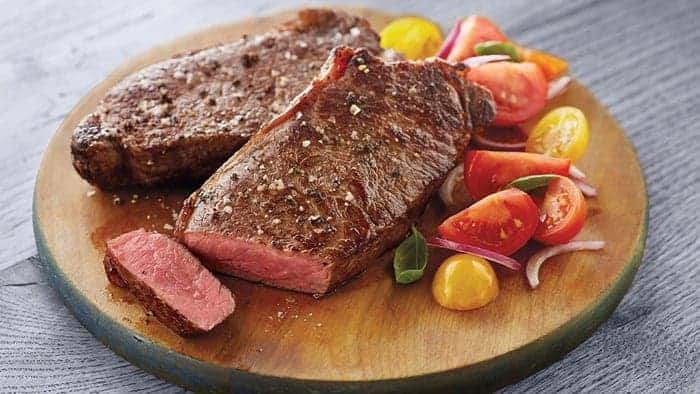
Savoring the Classic New York Strip (colorado- rib- eye and New York Strip)
Hailing from the less exercised short loin section of the steer, the New York Strip is a marvel of taste and texture.
Inherently tender due to its origins in a more ‘restful’ area of muscle, each bite offers a perfect blend of mouth-watering marbling and robust beefy flavor.
Typically served up in hearty 16-ounce portions—although your local butcher wouldn’t blink at customizing its size—the NY Strip is wonderfully versatile when it comes to cooking techniques.
Effortlessly seared on a high-heat stovetop or sizzled over grill grates, achieving that ideal crust outside while keeping things juicy inside is part of this steak’s undeniable charm.
What truly adds another dimension to enjoying an NY Strip is pairing it with wine. Given its harmonious balance between tenderness and chewy satisfaction, full-bodied red wines are its perfect companion.
A bold Cabernet Sauvignon or an elegant Bordeaux will find their tannins softened by the steak’s fat content while their acidity provides a counterbalance that cuts through richness like a knife through butter.
6. California
With influences ranging from Mexican carne asada tacos using flank or skirt steak marinated in citrus juices and chilies to health-conscious trends favoring lean cuts like sirloin or filet mignon paired with fresh salads or seasonal vegetables.
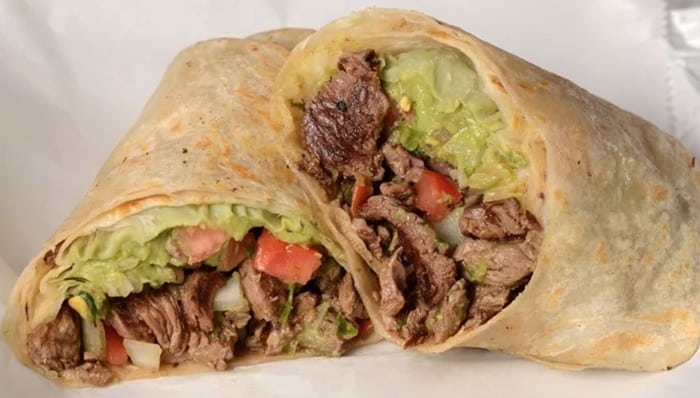
Carne Asada California: A Fiesta of Flavors
Sizzling, savory, and sensationally mouthwatering, Carne Asada California is the quintessential meal synonymous with sun-drenched days and lively family gatherings.
This deliciously marinated grilled steak has become a beloved staple at dinner tables across the Golden State.
Juicy Cuts Marinated to Perfection
The magic begins with premium cuts of beef—typically flank or skirt steak—that are bathed in a robust marinade concocted from an array of seasonings including lime juice, garlic, cilantro, chili powder, and other aromatic spices.
The meat soaks up these flavors as it tenderizes in the citrusy concoction that pays tribute to both Mexican culinary prowess and Californian innovation.
Grilled to Satisfy Your Cravings
After marinading for hours (or even overnight), Carne Asada steaks hit the hot grill grates where they’re seared to medium-rare perfection—creating an enchanting texture play in each bite.
7. Carolina Lowcountry
Here you’ll find more creative takes on Southern barbecue traditions incorporating various spices into marinades for flavorful char-grilled steaks often accompanied by sides like sweet potatoes or collard greens.
The type of meat matters and what wood you burn is part of the magic too. But folks, it is the SAUCE that truly makes your taste buds do a happy dance.
From Carolina shores to ‘Bama’s heartland over to Mississippi blues territory and up through Tennessee’s smoky mountains—you’ll find sauces as varied as our Southern accents.
You’ve got some sweet-spiced tomato-y delights playing tug-of-war with punchy mustard twangs and vinegary sizzles that’ll wake up your mouth like a morning bell!
Let’s chat about North Alabama’s notorious contender—the white sauce! Thick and creamy enough to make gravy green with envy.
The legendary Big Bob Gibson Bar-B-Q outta Decatur dreamed up this white wonderment. It’s a mayo-based alright—with zesty partners- such as vinegar (white for sure), horseradish for kickin’ it up notch, apple juice for sweetness-with-attitude, and lemon juice for that citrus high-five. But wait—there’s more!
Cast those napkins aside because we’re diving deep into BBQ paradise—one saucy tale at a time!
8. Montana
Big Sky Country appreciates big portions when it comes to steak; ribeyes served almost rarely dominate many Montanan menus reflecting a desire for straightforward cooking methods centered around open-fire grilling that captures frontier-style dining experiences.
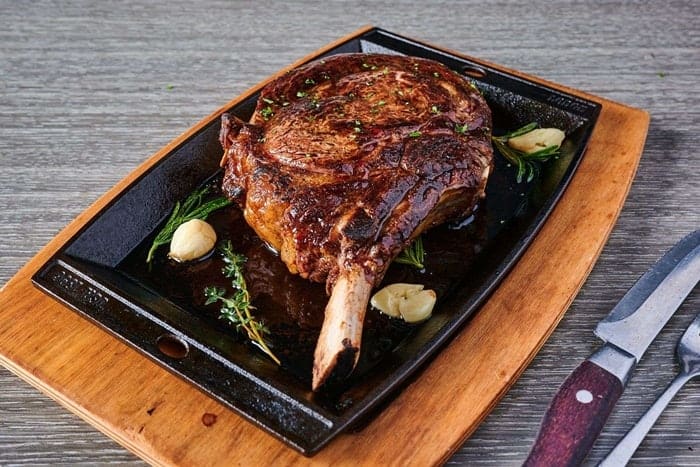
Picture this: a whopper of a bone-in Tomahawk Ribeye Steak reverse-seared to perfection, the kind that makes your heart skip a beat and your mouth water faster than you can say ‘Big Sky Country.’
But wait—do you even know what a Tomahawk steak is?
When we talk about feeding your crew, trust us—a big ol’ Tomahawk steak sliced from the bone feeds at least two hungry souls or more if you’re feeling generous.
Now let’s get down to brass tacks—the reverse searing part. On any grill—smoker, gas burner, or good old charcoal beast—you crank it low to start then jack up that heat until it sizzles.
Here’s what you need:
- One monster Felton Angus Beef Tomahawk Ribeye
- Your best rub (salt & pepper do wonders but don’t be afraid to flirt with something sassy like Caribeque Big & Bold)
Cooking direction breakdown:
- Preheat grill to 225°F – we aim for precision.
- Pull out that steak 30 minutes before showtime.
- Give it some love with your favorite rub.
- Grill over indirect heat till she hits 110°F internal temp – be patient; greatness takes time.
- Crank all burners high or stoke those flames!
- Return steak for the sear-heavy encore on each side for about 2-3 magic minutes.
- Strive for Medium Rare Nirvana at about 130-135°F final temp – because who likes overcooked beef jerky?
8. Let her rest! A good ten-minute breather goes a long way.
9. Slice against the grain so every piece bites back with savory goodness.
Folks might say everything’s bigger in Texas—but once they’ve sunk their teeth into this Montana-style masterpiece, they’ll understand why ‘Reverse Seared’ and ‘Tomahawk’ will become tried-and-true buzzwords in their BBQ vernacular.
Fire up the grill and prep yourself for an epic journey across the culinary plains where meat rules supreme—it’s time to eat big under that big sky!
9. New Orleans
Louisiana brings a Creole & Cajun flair that transforms ordinary steaks into spicy delights; whether through peppery seasonings akin to “blackening”, or being drenched in sumptuous crawfish etouffee sauce blending oceanic flavors seamlessly with land fare items creating uniquely NOLA offerings.
Hey there, spice lovers!
Homemade New Orleans Cajun Seasoning and Rub.
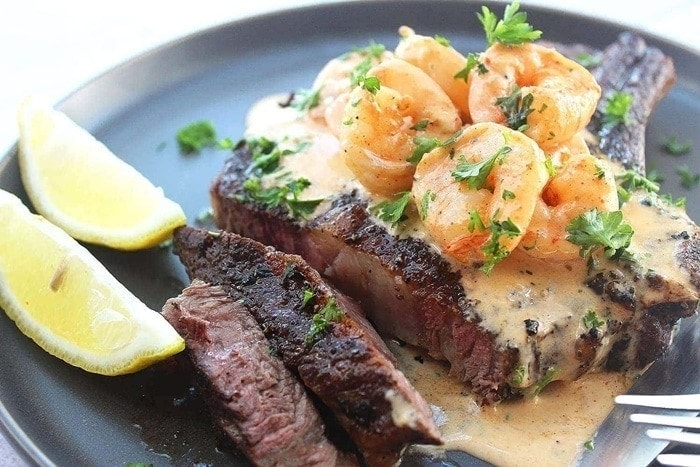
Trust me, this is not just any ol’ mix – it’s a DIY flavor explosion that’ll transport you straight to the bustling streets of Louisiana with every mouthwatering bite.
So, what’s all the fuss about Cajun Seasoning?
You’ve got yourself something mighty special. It jumps out with peppery punches — white pepper (so underrated), black pepper, cayenne pepper (hello heat!), and yes ma’am, plenty o’ bell peppers bubblin’ away in some creole cauldron.
Paprika sprinkles in smoky whispers while garlic quietly assures everything’s on track. Now where do you let these flavors loose?
Gather ‘Round for Your Spice Shopping List:
- Paprika (Go for smoked if you want that delightful campfire vibe.)
- Cayenne Pepper
- Black Pepper
- White Pepper
- Oregano (Because herbs always know how to party.)
- Onion Powder
- Garlic Powder
- SaltThe Secret Ingredient
- White Pepper!
Is It Spicy?
Cajun’s reputation for being bold ain’t no joke. Moreover, these regional differences extend beyond types of cuts and preparations—they also influence how steaks are consumed within meals themselves whether starring alongside hearty side dishes typical within each vicinity (engrained through customs passed down generations).
Additional beef cuts in the United States:
Filet mignon (Maine)
The name alone evokes a sense of gourmet dining and elegant evenings out. Revered for its tenderness and delicate flavor, this esteemed cut comes from the smaller end of the tenderloin located along the spine of the cow, an area that doesn’t do much work, hence its signature softness.
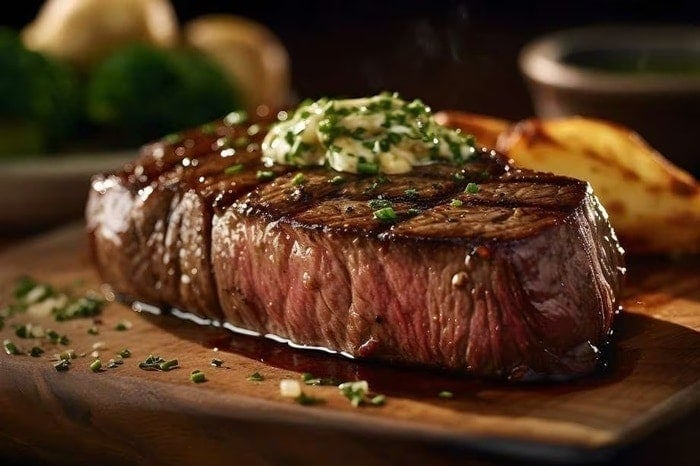
When cooked right, this steak needs no heavy sauces or extravagant seasonings to shine; simplicity is key to letting its reputation as “the king of steaks” stand unchallenged on your palate.
Whether you lean towards a grass-fed source for ethical reasons or taste preference filet mignon holds a place at the pinnacle of steak cuts not only for what it brings to the table in luxury but also for how effortlessly it turns dinner into an occasion.
So when you’re looking for something truly special on which to feast—be it at a high-end restaurant or from your own kitchen—a well-prepared filet mignon promises an eating experience filled with indulgence and distinction.
Sirloin…(Idaho-Arkansas)
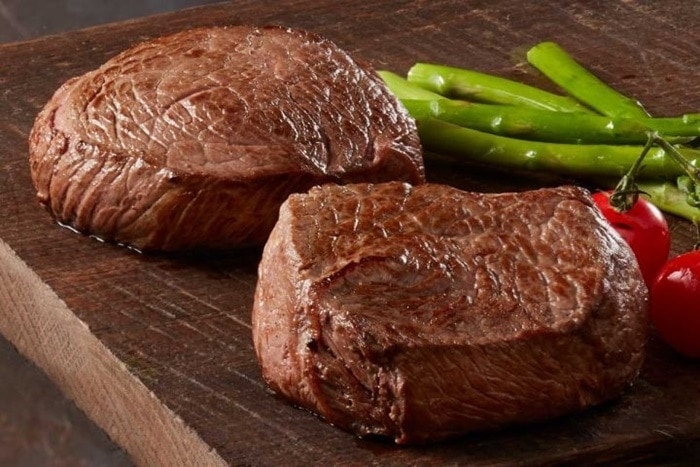
Nestled between the last rib and the hip bone of a bovine is a section beloved by steak enthusiasts—the sirloin.
Comprised primarily of two tender muscles—gluteus medius and biceps femoris—top sirloin crowns itself as the more tender counterpart to its tougher neighbor, bottom sirloin.
Free from bones and containing minimal connective tissue, top sirloin boasts lean characteristics yet offers ample juiciness when cooked properly.
For those health-conscious carnivores or anyone savoring simplicity without sacrificing succulence, this steak shines brightest when seared to medium-rare or rare perfection.
It turns up on grills and pans in various guises; sometimes you’ll find it sporting a decadent cap of fat which can be rendered down to infuse your meat with an extra layer of flavor.
Let’s not overlook its versatility! Whether cloaked in sumptuous sauces or starring in gourmet creations, top sirloin doesn’t shy away from dressing up—or down.
It confidently caters to fine dining experiences while remaining humbly suitable for your casual weeknight cookout.
So next time you’re contemplating cuts at your local market or scanning menus for that perfect steak experience, remember: top sirloin delivers all the tenderness and taste fit for royalty—even if you’re just reigning over your backyard BBQ! 99%
Flat iron steak
Hey, friends of the flame! Let’s talk flat iron steak. This gem is like that best-kept secret in your recipe repertoire; it knows how to mingle with marinades and please palates across the board.
Now, lean in for a juicy tidbit: flat iron steaks come from the storied shoulder of our bovine buddies – often dubbed “the chuck.”
Picture a rectangular piece of beefy beauty sporting some seriously enviable marbling throughout its canvas. That my friends is what gives the flat iron its superpower: juiciness that’ll have everyone reaching for seconds.
Imagine gathering around your backyard barbecue sanctuary—a place where good times sizzle alongside good eats—and laying down some thick, even-thickness flat iron steaks by Food Fire Friends’ guidebook. As they grill to perfection, those ribbons of fat start working their magic, turning into flavor you can’t resist.
Greetings! I’m Chad, a 43-year-old barbecue aficionado hailing from the beautiful state of Texas. I’m thrilled to invite you on a culinary journey as we explore the art of grilling and smoking together. Through this blog, I aim to ignite your passion for barbecue by offering:
Scrumptious, time-honored BBQ recipes passed down through generations, guaranteed to tantalize your taste buds.
Expert guidance on mastering the grill, smoker, and diverse cooking techniques to elevate your barbecue game.
Recommendations on choosing the perfect tools and equipment tailored to your grilling requirements.
An inside look at the latest trends, innovations, and advancements in the ever-evolving world of barbecue.

